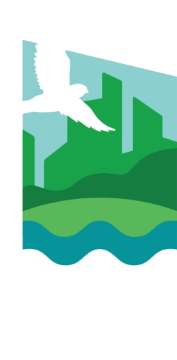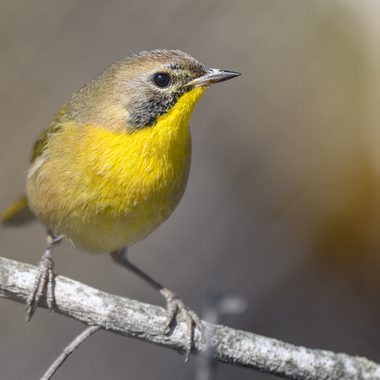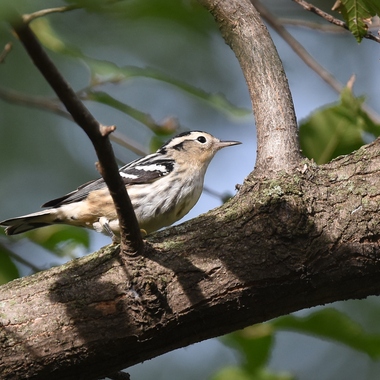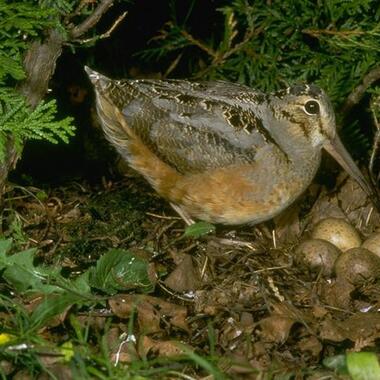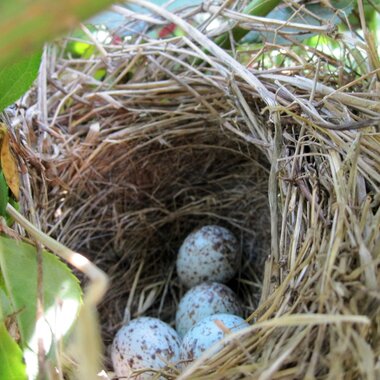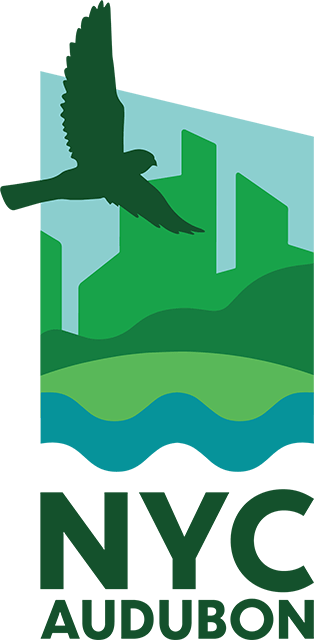Project Safe Flight
Yellow Warblers migrate through New York City, stopping in our parks to feed and rest. This beautiful species also nests in all five boroughs. Photo: Pat Schleiffer
Helping Birds Migrate Safely Through New York City
Every spring and fall, millions of birds migrate through New York City, journeying along the “Atlantic Flyway” from wintering territory in South and Central America to breeding grounds as far north as the Arctic Circle. As this huge variety of birds—from songbirds to raptors to hummingbirds to shorebirds—repeat their ancient cycle of migration, they encounter two relatively new threats: glass windows and artificial nighttime lighting.
And the encounter is a deadly one: according to NYC Audubon’s research, between 90,000 and 230,000 of these migrating birds are killed in the City each year in collisions with building glass, a death toll to which artificial lighting contributes by disorienting nocturnally migrating birds.
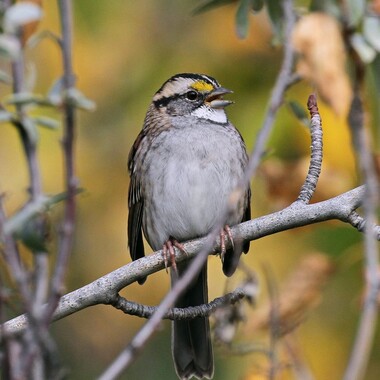
The White-throated Sparrow, known for its sweet, plaintive song, spends the winter in New York City. It is the most frequently found collision victim here since 1997, according to Project Safe Flight data. Photo: John Pizniur/Great Backyard Bird Count
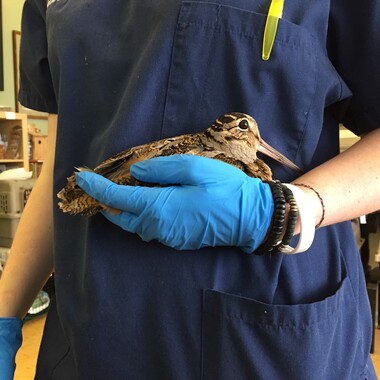
The shy and well-camouflaged American Woodcock both migrates through and nests in New York City. Many woodcocks become bewildered as the attempt to navigate the City's terrain of glass and cement. This bird was taken to Manhattan's Wild Bird Fund to be rehabilitated. Photo: MaryJane Boland
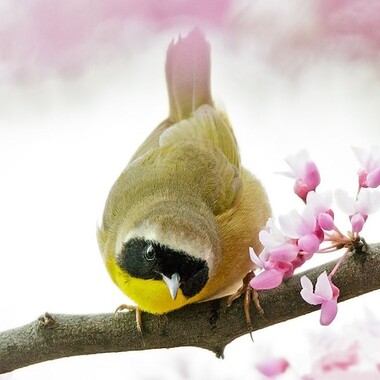
The Common Yellowthroat, indeed a common migrant and breeding bird in New York City's wilder spots, is the most frequently found collision victim here, among the warber species. Photo: Laura Meyers
The Key Contributors to Bird Collisions
Glass
Birds do not detect clear glass as a barrier, nor do they understand reflections in glass. When they see habitat or sky either reflected in glass, or through it, such as in a courtyard, the birds collide at full speed. Many die on impact. New York City, with its skyscrapers and huge swaths of reflective glass, poses a particular threat to over 100 species of migratory birds, some of which are experiencing long-term population declines. Glass is the second-largest direct cause of bird mortality in the U.S.1 (second only to free-roaming domestic cats). Research indicates that across the entire U.S., 365 million to 1 billion birds are killed annually in collisions with windows.
Artificial Light
A contributor to the problem of glass is artificial night-time lighting. Many birds, including most songbirds, migrate at night, and artificial light has been shown to attract and disorient them. When point sources of light, such as brightly lit skyscrapers and upward-facing beams, project into these birds' migratory airspace, the birds may be attracted to the glow. They may then be either injured as they flutter confusedly about the lights, or become exhausted and settle in inhospitable areas that make them more vulnerable to collisions. The urban glow from cities along migration routes can cause birds to orient towards and stopover in cities, potentially choosing lower quality habitat and heightening collision risk.
Birds do not detect clear glass as a barrier, nor do they understand reflections in glass. When they see habitat or sky either reflected in glass, or through it, such as in a courtyard, the birds collide at full speed. Many die on impact. New York City, with its skyscrapers and huge swaths of reflective glass, poses a particular threat to over 100 species of migratory birds, some of which are experiencing long-term population declines. Glass is the second-largest direct cause of bird mortality in the U.S.1 (second only to free-roaming domestic cats). Research indicates that across the entire U.S., 365 million to 1 billion birds are killed annually in collisions with windows.
Artificial Light
A contributor to the problem of glass is artificial night-time lighting. Many birds, including most songbirds, migrate at night, and artificial light has been shown to attract and disorient them. When point sources of light, such as brightly lit skyscrapers and upward-facing beams, project into these birds' migratory airspace, the birds may be attracted to the glow. They may then be either injured as they flutter confusedly about the lights, or become exhausted and settle in inhospitable areas that make them more vulnerable to collisions. The urban glow from cities along migration routes can cause birds to orient towards and stopover in cities, potentially choosing lower quality habitat and heightening collision risk.
NYC Audubon works to protect birds where the lighting hazard is clear and solvable, such as the Tribute in Light—while our research focuses on achieving a better understanding of the relationship between night-time lighting and bird deaths from collisions.
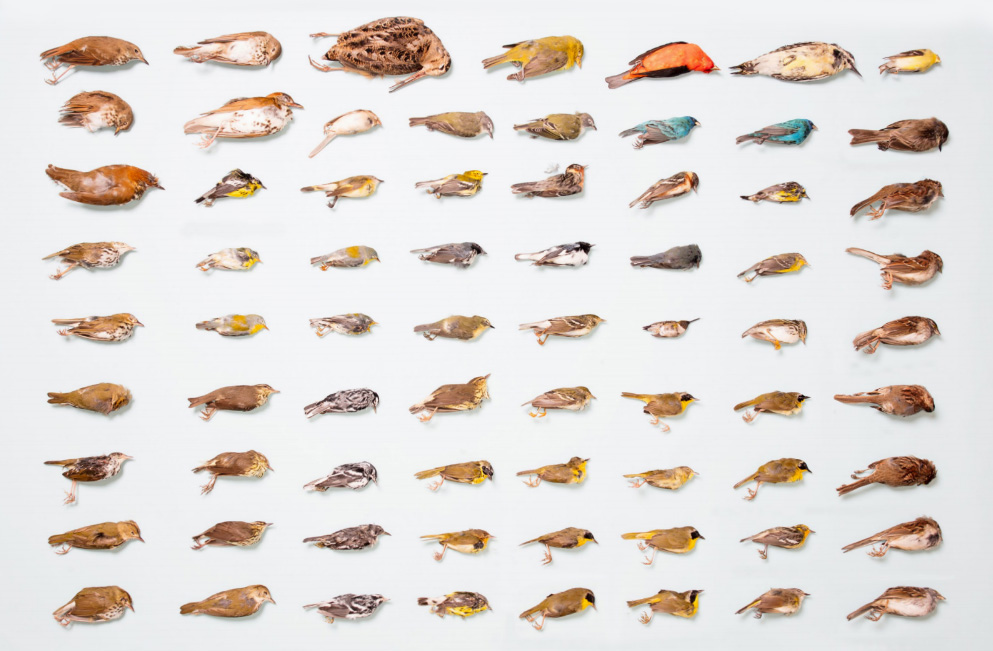 "}" data-trix-content-type="undefined" class="attachment attachment--content">
"}" data-trix-content-type="undefined" class="attachment attachment--content">Seeking Solutions: Project Safe Flight
In 1997, Project Safe Flight founder Rebekah Creshkoff found a dead Common Yellowthroat in the Financial District. Puzzled to find this beautiful songbird in such an unlikely spot, she investigated the problem and soon recruited early volunteers Allison Sloan, Ned Boyajian, and Kellie Quiñones to collect dead birds and monitor several buildings in downtown Manhattan. They discovered a problem much greater than they ever could have imagined. Project Safe Flight was born.
Now over two decades old, it has grown to include several complementary components aimed to reduce bird deaths from window collisions in New York City:
profiles2
Collision Monitoring

A stunned male Chestnut-sided Warbler is gently collected by a Project Safe Flight collisions monitor, before being taken to a rehabilitator. Photo: Sophie Butcher
Dedicated Project Safe Flight volunteers walk regular routes during spring and fall migration to find dead and injured birds, contributing to our long-term data set in conjunction with our online dBird data-collecting tool. Our data helps to pinpoint the City’s deadliest buildings, and provides evidence we can use as we seek change—whether realistic solutions at specific buildings, or larger policy wins.
Collision Monitoring
Dedicated Project Safe Flight volunteers walk regular routes during spring and fall migration to find dead and injured birds, contributing to our long-term data set in conjunction with our online dBird data-collecting tool. Our data helps to pinpoint the City’s deadliest buildings, and provides evidence we can use as we seek change—whether realistic solutions at specific buildings, or larger policy wins.
Bird-Friendly Building Design
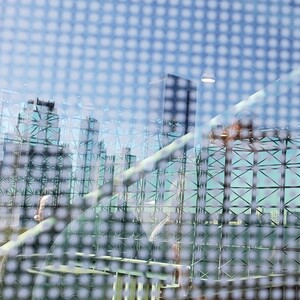
The fritted design of bird-friendly glass at the Jacob K. Javits Convention Center allows birds to see the building's glass and avoid collisions; since a renovation to the building, bird collisions have been reduced by as much as 90 percent. Photo: Stephanie Kale
We fight to enact city and state legislation that mandates bird-friendly building practices. Our most recent victory was the December 2019 passage of Int. 1482/Local Law 15 by the New York City Council. This milestone legislation requires that all new construction and significantly altered buildings use bird-friendly materials. We also educate and work with policy-makers, developers, architects, and building owners to reduce the hazards of glass and lights through the use of bird-friendly design principles.
Bird-Friendly Building Design
We fight to enact city and state legislation that mandates bird-friendly building practices. Our most recent victory was the December 2019 passage of Int. 1482/Local Law 15 by the New York City Council. This milestone legislation requires that all new construction and significantly altered buildings use bird-friendly materials. We also educate and work with policy-makers, developers, architects, and building owners to reduce the hazards of glass and lights through the use of bird-friendly design principles.
Artificial Light
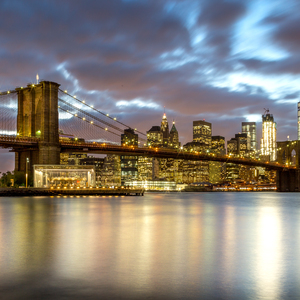
The New York City Skyline at night. Photo: Adriano BIDOLI/CC BY-NC-ND 2.0
We work with research partners to better understand the impact of artificial night-time lighting on migrating birds, and its relationship to bird deaths from collisions with building glass. Though most collisions occur during the day, the amount of light emitted by a building is a strong predictor of the number of collisions it will cause. Following the recent passage of bird-friendly design legislation, NYC Audubon plans to advocate for legislation requiring a reduction in artificial night-time lighting during spring and fall migration.
Artificial Light
We work with research partners to better understand the impact of artificial night-time lighting on migrating birds, and its relationship to bird deaths from collisions with building glass. Though most collisions occur during the day, the amount of light emitted by a building is a strong predictor of the number of collisions it will cause. Following the recent passage of bird-friendly design legislation, NYC Audubon plans to advocate for legislation requiring a reduction in artificial night-time lighting during spring and fall migration.
Tribute in Light Monitoring
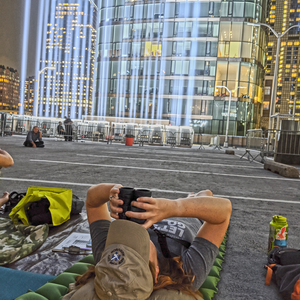
Volunteers monitor the Tribute in Light Memorial. Photo: NYC Audubon
Each September 11, we monitor the National September 11 Memorial & Museum’s Tribute in Light to prevent migrating birds from coming to harm. In addition to ensuring the Tribute is safe for birds, NYC Audubon collaborates with Cornell Lab of Ornithology at the site to further our understanding of the effects of artificial light on birds. Our research has demonstrated that the Memorial’s twin beams can attract bird densities up to 150 times higher than when the lights are not on.
Tribute in Light Monitoring
Each September 11, we monitor the National September 11 Memorial & Museum’s Tribute in Light to prevent migrating birds from coming to harm. In addition to ensuring the Tribute is safe for birds, NYC Audubon collaborates with Cornell Lab of Ornithology at the site to further our understanding of the effects of artificial light on birds. Our research has demonstrated that the Memorial’s twin beams can attract bird densities up to 150 times higher than when the lights are not on.
Bird-friendly Actors
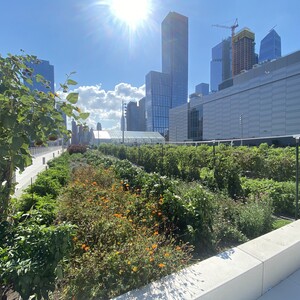
The Farm atop the Javits Center. Photo: NYC Audubon
Our work with building partners makes New York City safer for birds, including reducing the 230,000 bird deaths from building collisions that occur annually. We applaud property managers and building owners who have taken voluntary steps to adopt bird-safe glass. Check out our list of bird-friendly buildings below to see examples of buildings taking action to reduce its impacts on collisions.
Bird-friendly Actors
Our work with building partners makes New York City safer for birds, including reducing the 230,000 bird deaths from building collisions that occur annually. We applaud property managers and building owners who have taken voluntary steps to adopt bird-safe glass. Check out our list of bird-friendly buildings below to see examples of buildings taking action to reduce its impacts on collisions.
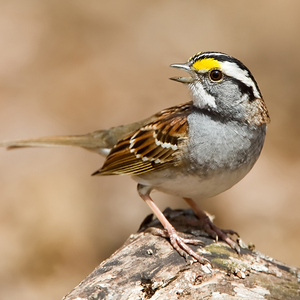
A “white-striped” White-throated Sparrow. Photo: David Speiser
White-throated Sparrow

White-throated Sparrow (Zonotrichia albicollis)
Among New York City’s most common birds, this familiar “winter sparrow” migrates through our area in great numbers, and many spend the colder months with us. The species breeds in the boreal forest across Canada and as far south as a few hours north of the City, and winters across the eastern U.S. and along the west coast. “White-throats” begin arriving in our area in September, and most depart by the end of May.
Known by its distinct white throat and eyebrow, with a yellow spot by the eye, this large, long-tailed sparrow comes in two “morphs” that coexist in the same population and are most apparent during breeding season: a bright “white-striped” form and a less distinct “tan-striped” form.
The White-throated Sparrow’s song is among the most familiar birdsongs, often thought of as “Oh, Canada… Canada… Canada…” or “Sam Peabody… Peabody… Peabody….” And the species’ song has been the subject of much research, both about birdsong-learning, and most recently, about a rapidly adapted new song variant across North America. White-throats are often heard rather than seen even in the depths of winter, when their high-pitched “zeet” notes and deeper, repeated alarm notes can be heard as they scratch about in the leaf litter of wooded parks, and even small patches of trees and shrubbery, across the City.
According to the North American Breeding Bird Survey, the species’ population declined by about 35 percent between 1966 and 2014 over most of its range, but declined 63 percent in the U.S. over that same time period. White-throated Sparrows are also among the top three collision victims in Toronto, according to their Fatal Light Awareness Program (FLAP) data. In addition to deaths from collisions, contributors to the decline in the White-throated Sparrow population may include habitat loss and pesticide use on the birds’ breeding grounds.

A “white-striped” White-throated Sparrow. Photo: David Speiser
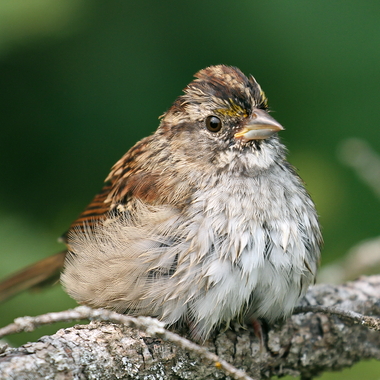
Tan-striped” White-throated Sparrows can be quite drab, as can young birds in the fall. Many collision victims are first-year birds, migrating south for the first time. Photo: John Pizniur/Great Backyard Bird Count
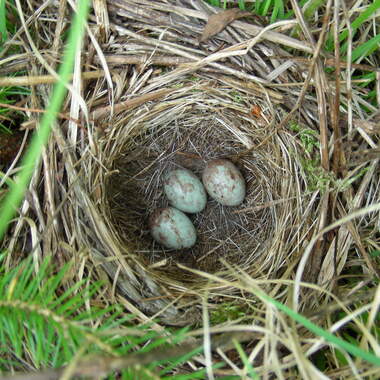
White-throated Sparrows usually nest on the ground. (This photo was taken in the mountains of Northern Vermont.) Photo: Kent McFarland/CC BY-NC 2.0
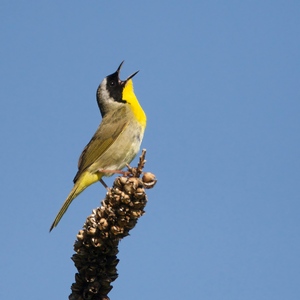
Male Common Yellowthroats sing on nesting territory in many of New York City’s larger parks. Photo: Keith Carver/CC BY-NC-ND 2.0
Common Yellowthroat

Common Yellowthroat (Geothlypis trichas)
Common Yellowthroat (Geothlypis trichas)
This small, wren-like warbler packs a lot of character in a small package. The “Yellowthroat” is a common migrant in the City, and is one of three warbler species that normally nest here (the others being Yellow Warbler and American Redstart). Common Yellowthroats breed across a large swathe of North America, and winter along both coasts and in Central America and the Caribbean.
This small, wren-like warbler packs a lot of character in a small package. The “Yellowthroat” is a common migrant in the City, and is one of three warbler species that normally nest here (the others being Yellow Warbler and American Redstart). Common Yellowthroats breed across a large swathe of North America, and winter along both coasts and in Central America and the Caribbean.
Yellowthroats are often among the first window-collision victims found during spring migration. The species starts arriving in our area in mid-April. In fall, most depart by the end of October. NYC nesting sites include Jamaica Bay and Alley Pond Park in Queens, Pelham Bay Park in the Bronx, Floyd Bennett Field and Calvert Vaux Parks in Brooklyn, Randall’s Island in the borough of Manhattan, and many sites on Staten Island.
The male yellowthroat’s very distinctive black “bandit” mask and bright yellow breast make him unmistakable, while the subtler female is best ID’d by its brownish upperparts, plain brown face, and yellow throat and undertail (often very drab in young birds). You can also recognize this species by its habit of skulking in lower shrubs and undergrowth, often with its tail cocked. Both male and female utter a harsh “chack” note, and occasionally, a high rattle. The male’s sweet “tiwitchity-witchity-witchity” is among the first warbler songs many learn.
According to the North American Breeding Bird Survey, the Common Yellowthroat’s population declined by about 38 percent between 1966 and 2014. In addition to deaths from collisions, likely contributors to the decline in the Common Yellowthroat population include habitat loss; the species may also be particularly vulnerable to pesticide use due to its habit of nesting in or near wetlands.

Male Common Yellowthroats sing on nesting territory in many of New York City’s larger parks. Photo: Keith Carver/CC BY-NC-ND 2.0
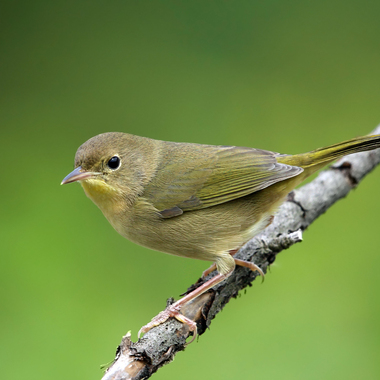
Young female Common Yellowthroats in the fall can be very drab; some show very little yellow at all. Photo: Tom Murray/CC BY-NC 2.0
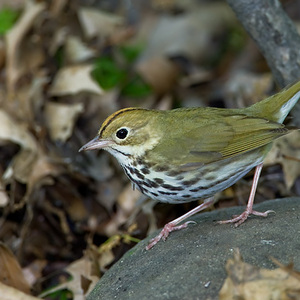
An Ovenbird demonstrates its classic strut. Photo: David Speiser
Ovenbird

Ovenbird (Seiurus aurocapilla)
In the running for our most “dapper” bird, the charming Ovenbird is a fairly common migrant in our wooded parks. The species breeds across eastern and midwestern North America and winters in southern Florida, Central America, and the Caribbean. The Ovenbird is often heard before it is seen—its ringing song of TeaCHER TeaCHER TeaCHER!, which rises in volume, coupled with its bobbing walk, have earned it the nickname “crescendo chicken.”
Ovenbirds strut across the forest floor with their short tails cocked, and are recognizable by this unusual stance and gait, soft olive-brown upperparts, spotted breast, and bright orange crown stripe. They breed in large woodlands within an hour of New York City, building a domed nest on the ground (which resembles an oven!).
According to the North American Breeding Bird Survey, Ovenbird numbers appear to have increased slightly between 1966 and 2014. This trend could be due to substantial regeneration of forest habitat from former farmlands across much of the eastern U.S., a change which has benefited other forest species like the Common Raven. Ovenbirds are known to be adversely affected by forest fragmentation from development, however, and by accompanying nest parasitism by Brown-headed Cowbirds.

An Ovenbird demonstrates its classic strut. Photo: David Speiser
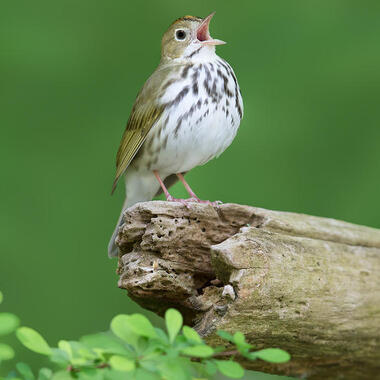
Ovenbirds often sing while stopping through New York City during migration. Photo: David Speiser
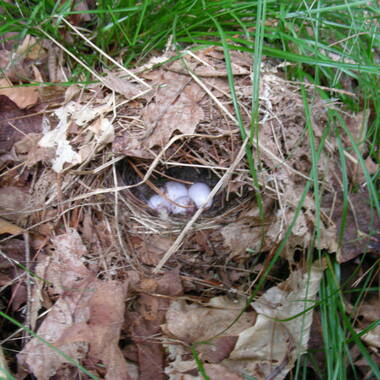
Ovenbirds are named for the oven-like nest they build on the ground. Photo: Kent McFarland/CC BY-NC 2.0
A male Dark-eyed Junco. Photo: Laura Meyers
Dark-eyed Junco
Dark-eyed Junco (Junco hyemalis)
Like its frequent feeding companion the White-throated Sparrow, the “snowbird” is known to us in New York City as a winter visitor. The species is widespread in North America, breeding across the entire continent as far north as the Arctic Circle, and wintering in the entire U.S. except for southern Florida. In our area, juncos start arriving in mid-September, but arrive in big numbers later in the fall; sadly, they make up the majority of our November window-collision victims. Juncos are a common sight here in the winter, though numbers vary from year to year. Most have departed by early May.
The species breeds in northern New England and in mountains as far south as Georgia. Summer visitors to the Catskills may be treated to the bird’s lightly trilled song, seldom heard off nesting territory. Look for wintering juncos in any park in the city, as they forage on the ground in groups, frequently with White-throated Sparrows. You may hear the birds’ rather electronic-sounding call notes before seeing them: both tinkling, rapid and uneven trills and single, video-game like notes.
The Dark-eyed Junco is an unusual species in that it comes in as many as 15 recognized subspecies, which differ in shades of gray and brown. (Several were once considered separate species.) All juncos are very distinct in appearance, dark and light. Among our “Slate-colored Juncos,” males have dark gray upperparts, while the females are lighter gray and brown above; both sexes have white bellies, whitish conical bills, and white tail edges that are usually apparent when they fly.
Though it is still a fairly common bird, the overall Dark-eyed Junco population declined by about 50 percent between 1966 and 2014, according to the North American Breeding Bird Survey.
A male Dark-eyed Junco. Photo: Laura Meyers
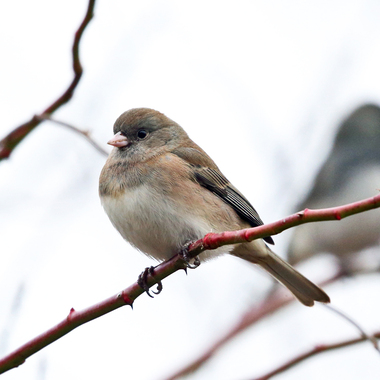
The upperparts of the female Dark-eyed Junco are a delicate combination of light grays and warm browns. Photo: Tom Murray/CC BY-NC 2.0
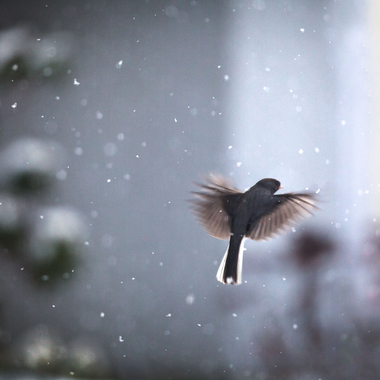
The junco’s white tail edges, which often flash when the bird takes flight, can provide a quick ID. Photo: Colleen Dubois/Audubon Photography Awards
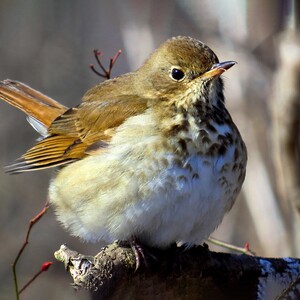
A Hermit Thrush characteristically cocks its tail upwards in a quick motion, and then slowly lowers it. Photo: David Cooney Jr./Great Backyard Bird Count
Hermit Thrush

Hermit Thrush (Catharus guttatus)
The Hermit Thrush is one of North America’s most renowned feathered songsters—but alas, New York City birders don’t often get to hear its ethereal flute-like tones, as it does not nest here and seldom sings during migration. This common migrant is the first spotted thrush to pass through in the spring, in early April, and the last to migrate through in the fall—arriving in late September and leaving by late November. A few stay the winter; New York City is right at the northern edge of the species’ wintering range. Hermit Thrushes breed in the Catskills, and may sometimes nest nearer by, on Long Island and in Harriman State Park.
While Hermit Thrushes are known to sing in New York City very early in the mornings or on overcast days in the spring, for the most part they must be ID’d by sight. Fortunately, the Hermit Thrush provides some very helpful cues, even for the beginning birder: Hermit Thrushes are often on the ground. Like the other spotted thrushes, the Hermit Thrush has brown upper parts and a spotted breast. It is distinct, however, in having a tail that is brighter orange-brown (or “rufous”) than its body. This rufous tail repeatedly cocks upward in a quick jerk, and then slowly settles downwards. (This tail-cocking is the Hermit Thrush’s “trademark move.”) The Hermit Thrush also has a very plain brown face, compared to the similar but “bespectacled” Swainson’s Thrush.
According to the North American Breeding Bird Survey, Hermit Thrush numbers remained stable between 1966 and 2014.

The Hermit Thrush characteristically cocks its tail upwards in a quick motion, and then slowly lowers it. Photo: David Cooney Jr./Great Backyard Bird Count
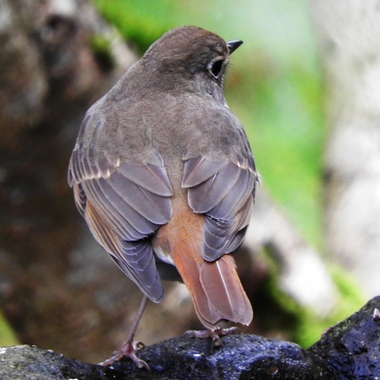
Just one glimpse of a Hermit Thrush’s bright rufous tail is often enough to ID it. Photo: Mark Ahlness/CC BY-NC-ND 2.0
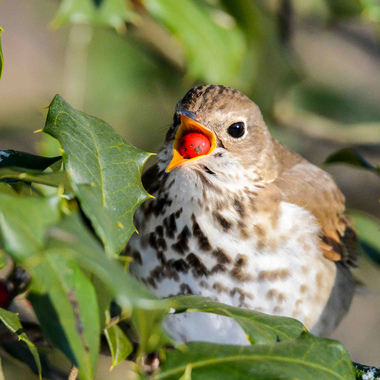
Hermit Thrushes often spend the winter in the City, sustaining themselves on long-lasting berries such as those of holly species. Photo: Jesse Gordon/Audubon Photography Awards
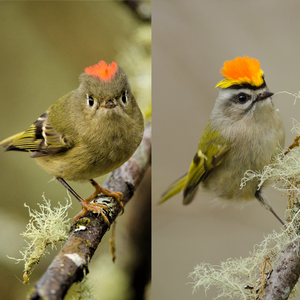
Two excited male kinglets: Ruby-crowned Kinglet (left) and Golden-crowned Kinglet (right). Left Photo: Jacob McGinnis/CC BY-NC 2.0; Right Photo: Jacob McGinnis/Audubon Photography Awards
Ruby-crowned Kinglet and Golden-crowned Kinglet

Ruby-crowned Kinglet (Regulus calendula) and Golden-crowned Kinglet (Regulus satrapa)
The charismatic kinglets, among the smallest birds of North America, are common in New York City during migration. Both also spend the winter here in smaller numbers, though the Golden-crowned Kinglet is a bit hardier. Both species breed across North America; the Ruby-crowned Kinglet’s breeding range is somewhat more northerly. (Golden-crowned Kinglets breed as close as the Shawangunk Mountains—while to find nesting Ruby-crowned Kinglets, one must head up to the Adirondacks.) The Ruby-crowned Kinglet’s winter range also extends further, all the way to the Yucatán—while the Golden-crowned Kinglet winters south to just over the Mexican border.
The slightly smaller Golden-crowned Kinglet is four inches long; among North American birds, only hummingbirds are smaller. Like hummingbirds, both kinglets sometimes hover as they feed on tiny insects in foliage and can be similarly oblivious to human presence, sometimes allowing birders to get astonishingly close.
Kinglets are recognizable by their tiny size and stubby tails, mossy-green upperparts, striking wingbar pattern, and quick, flitty behavior. The Golden-crowned Kinglet has the more patterned head of the two species, with a black eyeline and lateral crown stripe—and its yellow crown (with a fiery orange center in the male) is always visible. The Ruby-crowned Kinglet is remarkable for its comparatively plain face. Only the male sports a ruby crown; it is raised when the bird is excited, but is more often hidden.
According to the North American Breeding Bird Survey, between 1966 and 2014, the Ruby-crowned Kinglet population remained stable across the continent. The Golden-crowned Kinglet population, in contrast, declined 75 percent in the U.S. over this period—but this decline occurred in the western part of its range, while eastern populations appear to have increased slightly.

Two excited male kinglets: Ruby-crowned Kinglet (left) and Golden-crowned Kinglet (right). Left Photo: Jacob McGinnis/CC BY-NC 2.0; Right Photo: Jacob McGinnis/Audubon Photography Awards
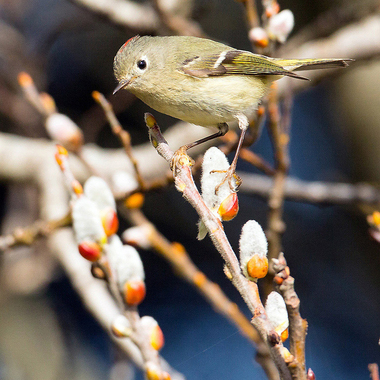
Often the crown of male Ruby-crowned Kinglet is just barely visible, or not visible at all; the female lacks the ruby crown completely. Photo: Lois Miller/Audubon Photography Awards
An adult female or first-year male Black-and-white Warbler (note the white throat) in a typical nuthatch-like position. Photo: Robert Cook/Audubon Photography Awards
Black-and-white Warbler
Black-and-white Warbler (Mniotilta varia)
This “nuthatch of the warbler world” is a common sight in our wooded parks during migration, as it creeps up, down, and around tree trunks and branches, foraging for insects in the bark. Black-and-white Warblers breed across much of Canada and the eastern and central U.S., and winter along our southeast coast, in the Caribbean, and in Latin America as far south as Ecuador.
A relatively early spring migrant in our area, the Black-and-white Warbler starts arriving in early April; its high, swinging song of SEE-see SEE-see SEE-see echoes through our forests through May. The species breeds as close as Harriman State Park, as well as on the eastern end of Long Island. Interestingly, though closely associated with trees, this warbler usually builds its nest on the ground. As it breeds so close by, it is one of the first fall migrants to arrive, some appearing in the City as early as July.
Black-and-white Warblers are well-named—their striped coloration, as well as their tree-trunk-creeping habit—make them easy to ID. (Adult males have more extensive black on their faces and throats.)
This species’ population declined by about 33 percent between 1966 and 2014, according to the North American Breeding Bird Survey. In addition to deaths from collisions, contributors to the decline in the Black-and-white Warbler population are thought to include pesticide use and the fragmentation of the species’ forest habitat.
An adult female or first-year male Black-and-white Warbler (note the white throat) in a typical nuthatch-like position. Photo: Robert Cook/Audubon Photography Awards
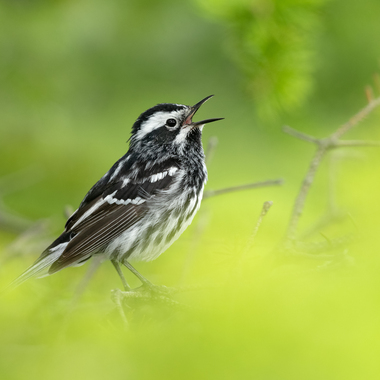
The high-pitched song of the male Black-and-white Warbler is a very common sound in New York City woodlands during spring migration. Photo: Brad James/Audubon Photography Awards
Disoriented American Woodcocks are a surprising but all too common sight on New York City sidewalks during migration. Photo: Teri Shors/Audubon Photography Awards
American Woodcock
American Woodcock (Scolopax minor)
During spring and fall migration in New York City, many a perplexed pedestrian has come across an unexpected sight on the sidewalk: an even more perplexed, richly patterned, plump brown bird with a very long bill and dark eyes set oddly back on the sides of its head. The migratory American Woodcock, an upland shorebird species, has a very hard time navigating its way through our city. Woodcocks are usually the first window-collisions found in early spring and the last species found in the fall.
A true bird of the East, the American Woodcock breeds throughout most of eastern North America, regularly wintering in the South and along the East Coast as far north as Massachusetts. The bulk of migrating woodcocks come through our area in March and April, and again in November and December.
Small breeding populations persist in a few preserved areas of mixed woodlands and meadows in New York City, including Jamaica Bay Wildlife Refuge in Queens, Brooklyn’s Floyd Bennett Field, and Freshkills Park on Staten Island. Experienced birders know to show up at these breeding sites at dusk in springtime, in order to witness the weird, wild spectacle of American Woodcock “sky dance” courtship: Males utter a comically nasal “peint” call before leaping dozens of meters into the sky, circling rapidly while producing a high twittering sound with both wings and bill. The birds then plummet suddenly to the ground, presumably in hopes they have awed females that sit nearby, evaluating their prospects.
Because of their secretive nature, population estimates are difficult, but the North American Breeding Bird Survey suggests that American Woodcock populations slowly declined between 1966 and 2014, with evident declines in areas including parts of the Mid-Atlantic and New England. The American Woodcock is on the 2014 State of the Birds Watch List, which lists species most in danger of extinction without significant conservation action.
In addition to deaths from collisions, likely contributors to a decline in the American Woodcock population include habitat loss and pesticide use; the birds may be particularly vulnerable due to contamination due to their diet of earthworms. In New York City, the birds’ nesting success may also be adversely affected by the presence of feral cats.
Disoriented American Woodcocks are a surprising but all too common sight on New York City sidewalks during migration. Photo: Teri Shors/Audubon Photography Awards
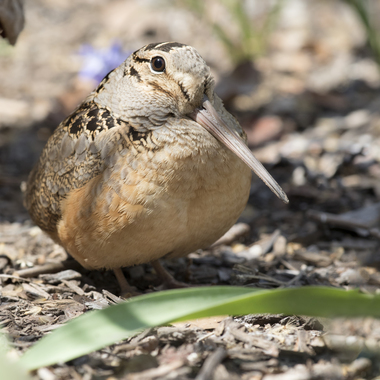
New York City birders can often get very good views of American Woodcocks in small parks like Manhattan’s Bryant Park, where the birds may stay for some time during migration or over the winter. Concerned birders often keep track of lingering birds for fear they may have been injured in window collisions. Photo: David Speiser
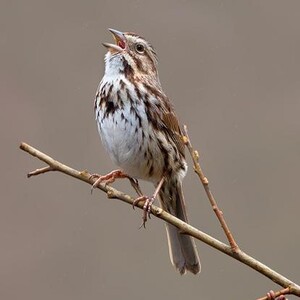
A singing Song Sparrow. Photo: David Speiser
Song Sparrow

Song Sparrow (Melospiza melodia)
This common striped sparrow, known for the dark spot it bears on its chest and the cheerful song it repeats all day long, is the sole year-round resident among this “top 10 list” of New York City collision victims. Though this widespread species is a resident across the northern U.S., it is also migratory, breeding as far north as southern Alaska and wintering across the southern U.S. and into northern Mexico. It is also a particularly diverse songbird, having at least 24 subspecies.
The very adaptable Song Sparrow breeds in all boroughs of New York City, including at least five parks in the borough of Manhattan. Numbers in the City swell during migration, in March and April and again in October and November, when it is common to see Song Sparrows feeding among larger mixed sparrow flocks in areas of shrubs and grass.
Compared to similar species like the Savannah Sparrow, the Song Sparrow is best ID’d by its relatively long tail, coarsely striped breast, central chest “blotch,” and fairly large, dark bill; it also often has a characteristic “hunched” posture, with its tail low, when feeding in the grass, compared to other sparrows.
Though still a common bird, the Song Sparrow’s population declined by about 30 percent between 1966 and 2014, according to the North American Breeding Bird Survey.

A singing Song Sparrow. Photo: David Speiser
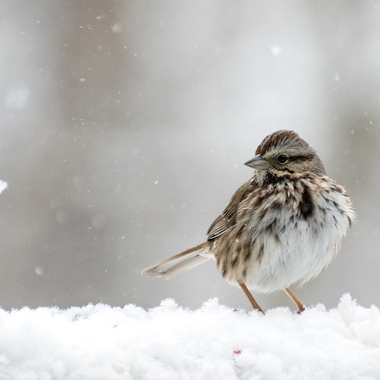
The hardy Song Sparrow is seen in New York City all year long. Photo: PJ Kaszas/Audubon Photography Awards
Project Safe Flight Resources and References
Bird-Friendly Building Design: Based on NYC Audubon's Bird-Safe Building Guidelines, this 2019 update by the American Bird Conservancy in partnership with NYC Audubon is the most authoritative resource on this issue.
LEED Pilot Credit in Reducing Bird Collisions: NYC Audubon, Bird-Safe Glass Foundation, and the American Bird Conservancy successfully worked with the U.S. Green Building Council to create this pilot credit for sustainable buildings.
Bird Collisions with Windows: An Annotated Bibliography by Chad L. Seewagen and Christine Shepherd
Bird Collisions with Windows: An Annotated Bibliography by Chad L. Seewagen and Christine Shepherd
Published Research Cited
1. Loss, S. R., Will, T., & Marra, P. P. 2015. Direct mortality of birds from anthropogenic causes. Annual Review of Ecology, Evolution, and Systematics, 46:99-120.
2. Loss, S. R., Will, T., Loss, S. S., & Marra, P. P. 2014. Bird–building collisions in the United States: Estimates of annual mortality and species vulnerability. The Condor, 116: 8-23.
Additional Published Research
Cabrera-Cruz, S. A., Smolinsky, J. A., & Buler, J. J. 2018. Light pollution is greatest within migration passage areas for nocturnally-migrating birds around the world. Scientific Reports, 8:3261.
Gelb, Y., & Delacretaz, N. 2009. Windows and vegetation: primary factors in Manhattan bird collisions. Northeastern Naturalist, 16: 455-470.
Parkins, K. L., Elbin, S. B., & Barnes, E. 2015. Light, glass, and bird—building collisions in an urban park. Northeastern Naturalist, 22: 84-94.
